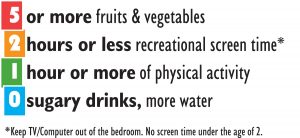Nutrition may not be on the list of your child’s favorite things but it is crucial to the process of early childhood development. Healthy eating in a child’s early years can increase their cognitive development and ability to learn for years to come. Brightside Academy is dedicated to implementing nutritional values into the lives of the children and families in the communities we serve. We provide healthy meals, including breakfast, lunch and dinner for all of our children, and are a proud participant of the Child and Adult Care Food Program (CACFP). The CACFP program provides aid to child care institutions such as Brightside, and distributes nutritious meals and snacks to more than 3.3 millions infants and children annually. Brightside provides home-style cooked meals that meets the needs of children of all ethnicity and backgrounds. “We serve the type of food in our centers that I would serve at home to my own children” says Amy Labosco, the VP of business services at BSA. The key to nutrition is not serving just healthy food, but food your children can get excited about.
Nutrition and the Child’s Growth
 Healthy food choices have a strong impact on a child’s growth. Discuss with your child’s doctor regularly to review the child’s weight and height. The doctor plots your child’s weight and height on a growth chart. This chart shows the relationship between your child’s height and weight, the curve of the chart is extremely important and monitors if the child’s weight and height are growing at the same rate. Your child’s growth can tell you about their nutritional needs. Each one of your child’s meals should include a fruit, a vegetable, grains, a source of protein and dairy. Recommendations on portion sizes for each age group can be found here.
Healthy food choices have a strong impact on a child’s growth. Discuss with your child’s doctor regularly to review the child’s weight and height. The doctor plots your child’s weight and height on a growth chart. This chart shows the relationship between your child’s height and weight, the curve of the chart is extremely important and monitors if the child’s weight and height are growing at the same rate. Your child’s growth can tell you about their nutritional needs. Each one of your child’s meals should include a fruit, a vegetable, grains, a source of protein and dairy. Recommendations on portion sizes for each age group can be found here.
Feeding a Picky Eater
Implementing a healthy eating style in your child’s life may seem difficult, especially if they are a picky eater. Here are some ways to tackle the picky eater in your life, but still offer them foods of high nutritional value:
- Allow them to be involved in the food making process; have a “taco making night”, kids get more excited about eating food that they helped make.
- Serve foods your child deemed as “yucky” in alternate ways, if the child doesn’t like cooked carrots try feeding them the carrots raw.
- “Save the best for last”; have your child eat the part of the meal they prefer the least first and eat their favorite foods last, this will encourage them to finish all of their food in record breaking time.
- Make family dinners fun and serve portions of the meal in phases instead of all at one time, this keeps the child engaged in every aspect of the meal.
- Incorporate the use of the child’s imagination during meal time, the classic “choo choo train” method always works. Or have the child pretend they are a giant and broccoli is the tiny trees they are eating.
Nutritional Workshops and Resources
Brightside Academy offers workshops on nutrition and exercise to parents in our communities. We partnered with the Phipps Conservatory and Botanical Gardens to host the Let’s Move Pittsburgh workshop which increased awareness, skills and abilities of our parents and families in the Pittsburgh area. The workshop informed parents about the Child Obesity Prevention Program which promotes the 5210 initiative. The program states that every child should have 5 or more fruits and vegetables, 2 hours or less of recreational screen time, 1 hour or more of physical activity and 0 sugary drinks daily. For more information on the CACFP and resources for nutrition and health and wellness, visit Food and Nutrition Service.Gov, Choose My Plate.Gov and Parenting.com. You can also visit any local Brightside Academy in your area and ask to view the current month’s menu. Be sure to like us on Facebook to see when we are hosting a workshop near you! Nutrition may seem like a difficult aspect of your child’s life to monitor but with these necessary tips and resources, your child will be eating healthier in no time!





